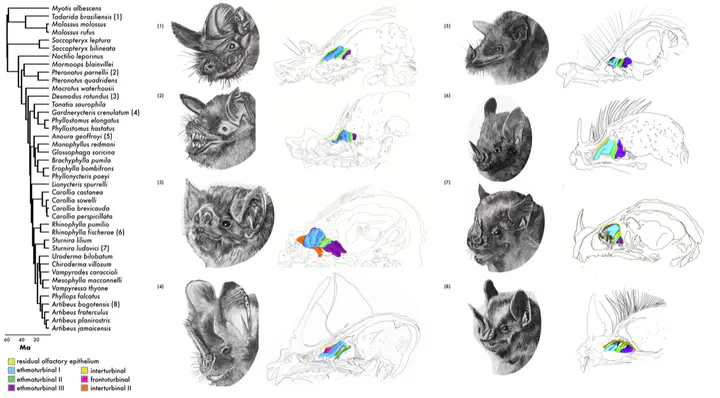Ecological constraints on highly evolvable olfactory receptor genes and morphology in neotropical bats
 Image credit: L.R. Yohe & S. Scranton
Image credit: L.R. Yohe & S. Scranton
Abstract
While evolvability of genes and traits may promote specialization during species diversification, how ecology subsequently restricts such variation remains unclear. Chemosensation requires animals to decipher a complex chemical background to locate fitness-related resources, and thus the underlying genomic architecture and morphology must cope with constant exposure to a changing odorant landscape; detecting adaptation amidst extensive chemosensory diversity is an open challenge. Phyllostomid bats, an ecologically diverse clade that evolved plant-visiting from an insectivorous ancestor, suggests the evolution of novel food detection mechanisms is a key innovation: phyllostomids behaviorally rely strongly on olfaction, while echolocation is supplemental. If this is true, exceptional variation of underlying olfactory genes and phenotypes may have preceded dietary diversification. We compared olfactory receptor (OR) genes sequenced from olfactory epithelium transcriptomes and olfactory epithelium surface area of bats with differing diets. Surprisingly, although OR evolution rates were quite variable and generally high, they are largely independent of feeding ecology. olfactory epithelial surface area, however, is greater in plant-visiting bats and there is an inverse relationship between OR evolution rates and surface area. Larger surface areas suggest greater reliance on olfactory detection and stronger ecological constraint on maintaining an already diverse OR repertoire. Instead of the typical case in which specialization and elaboration is coupled with rapid diversification of associated genes, here the relevant genes are already evolving so quickly that increased reliance on smell has led to stabilizing selection, presumably to maintain the ability to consistently discriminate among specific odorants - an ecological constraint on sensory evolution.